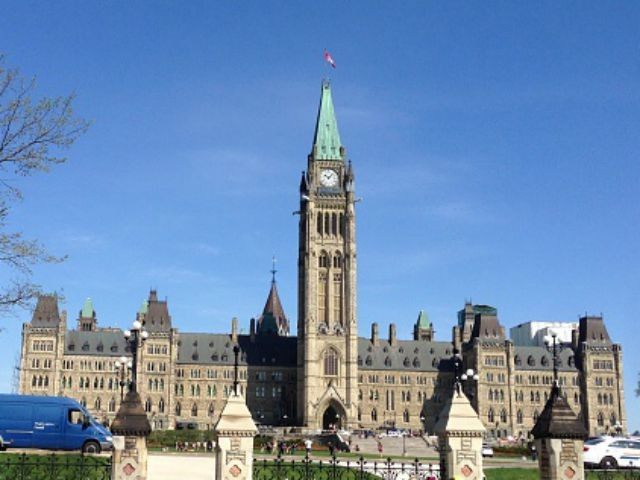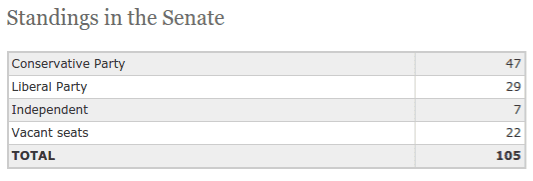The Canadian election is today, and Breitbart News thought it newsworthy to provide an introduction to the essentials of Canada’s federal electoral system for the uninitiated.
What’s happening today, what are the potential outcomes?
The House of Commons vs. The House of Representatives
As is the case in the United States, Canada has a bicameral legislature. The “lower chamber” of the legislature is the House of Commons, which can be thought of as a sort of Canadian equivalent to the American House of Representatives. On October 19, the number of seats in the HoC is being increased to 338, with 335 being assigned to the ten provinces based on provincial populations. The three territories each have one seat.
Ridings are to Canada, in a way, what districts are to America. The number of ridings in a given province is determined by the province’s population. More populous provinces have more ridings, and therefore more seats in the House of Commons. Just as California, Texas, Florida, and New York have the greatest weight in the electoral college, Ontario, Quebec, British Columbia, and Alberta have the greatest numbers of ridings relative to other provinces.
The Prime Minister’s Path vs. The President’s Path
A primary difference between Canada’s electoral system and America’s is that the former doesn’t hold an election exclusively for its Prime Minister. In Canada, the elections of the PM and HoC are fused into one. In America, via the constitutional separation of powers, presidential and congressional elections are partitioned. Presidential candidates win or lose entire states in their totalities. In Canada, both prime ministerial candidates and political parties win or lose ridings and not entire provinces. In America, it’s a winner-take-all system regarding the states for presidential elections.
Once the election is complete and a riding’s ballots are counted, the candidate with the highest number of votes wins the riding’s allocated seat in the HoC. This is Canada’s first-past-the-post system. If a single party wins a majority – at least 170 – of the HoC’s 338 seats, it will form the next government with its leader becoming the Prime Minister.
If no single party secures this majority, then parties will need to negotiate with one another and form a government via coalition which holds a majority – or at least a plurality – of the HoC’s seats. Alternatively, some MPs can defect to other parties in pursuit of the coveted one-party majority.
Canadian convention holds that an existing government is given first dibs on forming the next government in such a scenario, which essentially means an opportunity for political negotiation with other parties or MPs.
It also includes a pitch to the HoC to vie for its confidence, known as a Speech from the Throne. This is a straight up or down vote in which the prospective or incumbent PM requests and requires a majority of support from the HoC in order to form a minority government under his/her leadership. Canadian governments are required to preserve the ongoing confidence of the HoC, which means they must enjoy majority support on votes for the budget, specific confidence motions, and Speeches from the Throne. If the government fails to win majority support on any of these votes at any time, it loses the HoC’s confidence, and an election is held.
In the event that the existing government cannot maintain the confidence of the HoC, or foregoes the option of vying for it, the other parties will likely be given the option by the Governor General to enter negotiations to form a coalition government. If this fails, another election is held.
Minority governments in Canada, historically, have shorter lifespans than majority governments. They typically do not last for the entirety of their four-year mandates, usually losing the confidence of the HoC at some point beforehand.
Presidential vs. Prime Ministerial Powers
Given the fusion of the legislative and executive governmental branches in Canada as opposed to the separation of powers in the United States, Canada’s PM tends to be more politically powerful within the context of Canada than the American President is south of the border. The PM is simultaneously a legislator and executor. Canada’s PM also enjoys broad appointment powers to ministerships, judgeships, amabassadorships, senatorships, and heads of crown corporations without the hearing and approval processes seen in America. In this sense, prime ministerial powers – particularly in the context of a one-part majority government – eclipse those of a president.
The drama of the nomination processes in America, from Robert Bork to Clarence Thomas, cannot happen in Canada.
The broad powers of the PM contribute to greater fealty to his/her will and centralize more of the governmental agenda in his/her hands than is the case in America. Although this has been changing under President Barack Obama’s tenure with his deliberate expansion of executive power relative to both the judicial and legislative branches.
Party loyalty is stronger in Canada than in America. The great centralization of power within the PM maintains obedience to his/her will. Conversely, the system amplifies loyalty to would-be PMs from MPs in competing/opposition parties, hoping this investment of devotion will yield dividends in the event that their leader secures the 24 Sussex Drive (the official residence of the Prime Minister of Canada) in a future election.
Former United States Ambassador to Canada David Wilkins said, “In (Canada’s) form of government, particularly in a majority government, your prime minister has much more power concentrated in that one position than our president ever thought about having.”
The Senate vs. The Senate
Unlike being directly elected to six-year terms in America, Canada’s Senators are appointed to near-lifetime terms by prime ministers. It used to be the case that senators were appointed to lifelong terms, but now they serve until age 75. There are no more Senators left from the previous era of lifelong appointments. Similar to America, however, is the need for bills to be passed in Canada’s Senate in order to become law. Canada’s Senate has 105 seats, 22 of which are currently vacant. Prime Minister Harper has opted to not fill these seats to bolster the bona fides of his commitment to Senate reform, in lieu of which he has called for its abolition.
The only ways for an occupied senate seat to be vacated are if the senator dies, retires, or is impeached. This anti-democratic system has been the stuff of some political debate in Canada, with Prime Minister Stephen Harper expressing a desire for “Senate Reform,” often code for proposals for its abolition.
Such an outcome, however, would require constitutional reform contingent on a majority of senators voting for their own dismissals. If either of Harper’s competitors become PM, they will have the ability to immediately appoint 22 senators and have a long-term impact on Canadian legislation.



COMMENTS
Please let us know if you're having issues with commenting.